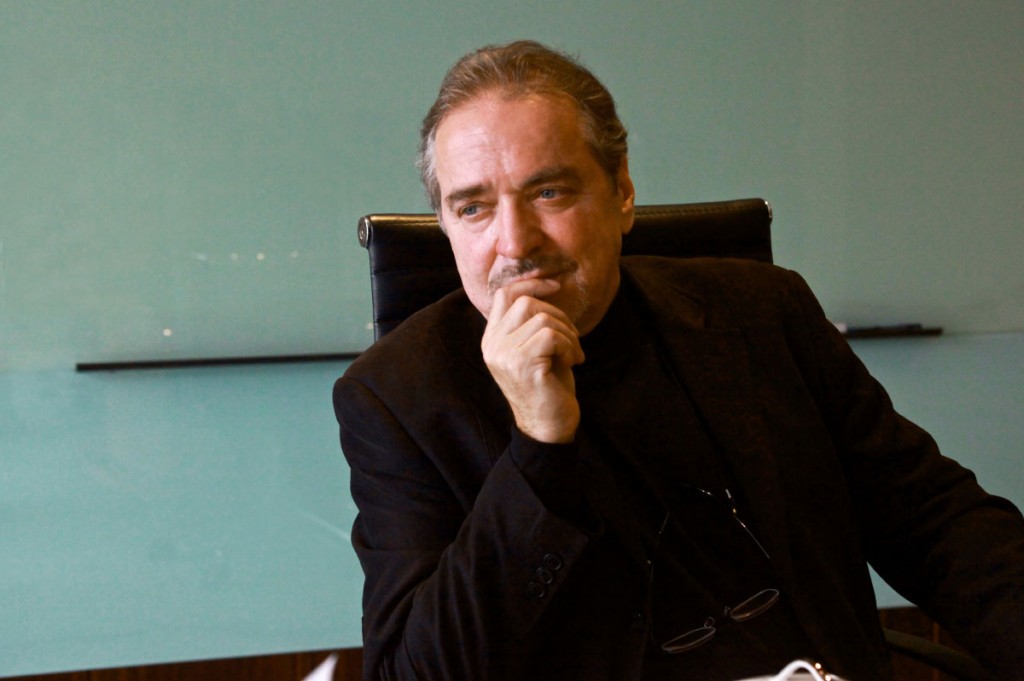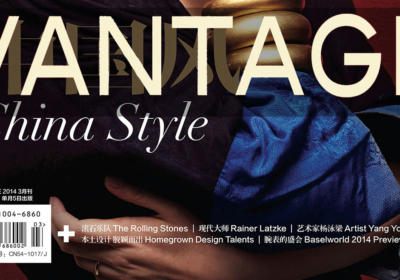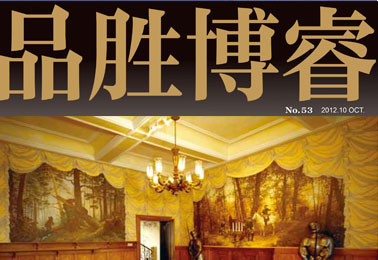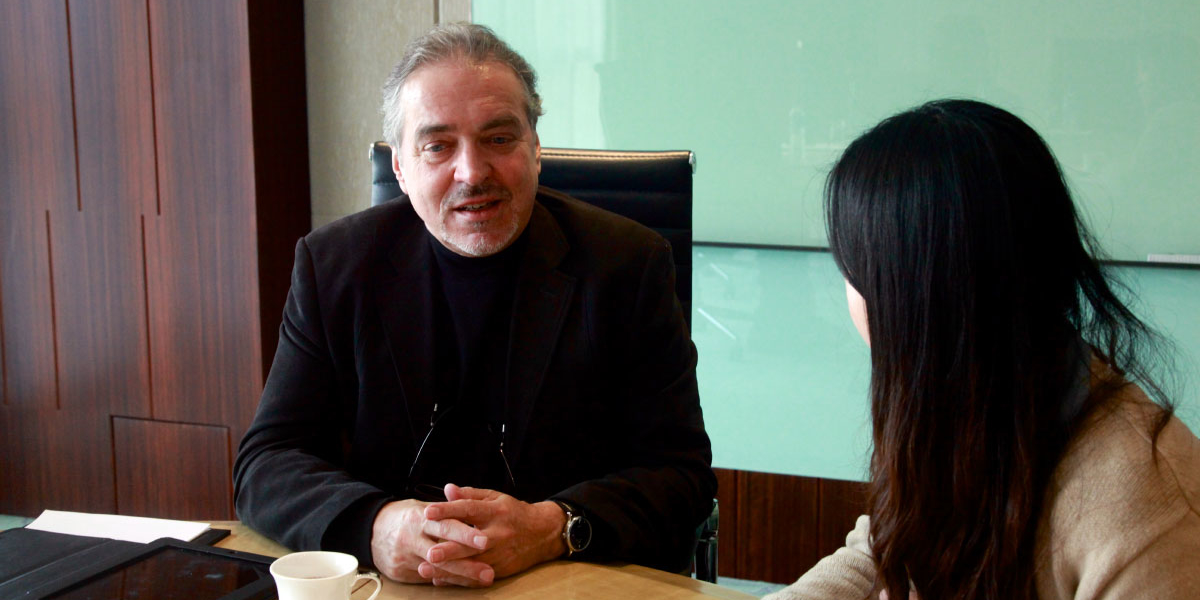
Vision China interviews Professor Rainer Maria Latzke
Beijing, China – Shijue.me/Visual China is China´s most significant internet platform about art and culture. Together with Getty Image it reaches over 500,000 registered visual designers. For its Master series it recently conducted an interview with Rainer Maria Latzke about his works and his view on art.
The Vision China interview
Rainer Maria Latzke, in China known as Li Haina is aknowledged as the, “Modern Day Michelangelo.” During this interview, he elegantly shares stories of growth and decades of experiences in mural painting. He is nicely dressed in a black suit emanating a strong German appearance and attitude. His friendly smile and humorous, wise demeanor makes for leisurely conversation. He speaks about the pursuit of art, that it is a pure road to follow but it is a hard road to accomplish. It is more important that we learn to apply our knowledge and realize the true value of art.
Visual China: Where are you living and what is it like?
Li Haina: I now live in Shanghai Songjiang. For me, it´s an interesting experience and a good life, comparable to or even better than in many other international cities. In China, one can truly feel the sense of hope here, and like Europeans in my opinion, Chinese people are so happy. China has developed rapidly which can create negative foreign media reports that often are misunderstanding; it may not be clever if western media reports such opinions, like if Germany, being relatively strong, won also in a game, it may not come across as attractive.
Visual China: Li Haina’s, a name you have been given, do you know the significance of this?
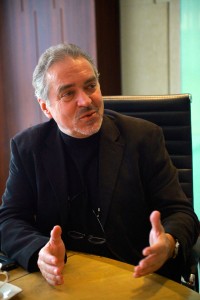 Li Haina: My German name is Rainer Maria Latzke. the name Rainer in German is pronounced in a small tongue which can make pronunciation difficult, like the Chinese word for “sea”. Latzke, which begins with L, has similar attributes such as “Lee.” During my first year here, DeTao CEO took me aside and said, “Your Chinese name should be called “Li Haina – Ocean full of everything”, meaning, to be tolerant and diverse. I think he named me pretty well!
Li Haina: My German name is Rainer Maria Latzke. the name Rainer in German is pronounced in a small tongue which can make pronunciation difficult, like the Chinese word for “sea”. Latzke, which begins with L, has similar attributes such as “Lee.” During my first year here, DeTao CEO took me aside and said, “Your Chinese name should be called “Li Haina – Ocean full of everything”, meaning, to be tolerant and diverse. I think he named me pretty well!
Visual China: You enjoy the “Modern Day Michelangelo” in the title, how do you understand this reputation?
Li Haina: First of all, Michelangelo was great artist, a person cannot go beyond his achievements, and if I was to try to turn the world’s greatest artists comparable to me, then I think this is would be a heavy burden, but it is definitely an honor to be at least considered to be somehow related to him. I am pleased to accept this reputation because I really like the Renaissance period. It was a very creative and special era, for example, Michelangelo was a painter, sculptor, architect and composer; Leonardo da Vinci was a painter, medic and inventor. He invented the first aircraft as a painter, and he did not drew too many paintings but did a lot of other things and when hie did something he just did it prefect and brilliant. He had multiple identities. I think my Chinese name – Li Haina, is fitting. I am not only a muralist, I was awarded patents for new technologies in painting production and construction.
Visual China: Mural art is a relatively ancient art form. How does the ancient art forms and modern digital technology impact society?
Li Haina: Digital technology today has a great influence in everything. this technology makes many things easier and convenient, such as writing, music and art. The invention of the I Phone with its software enabling to send out individually created postcards for example inspired David Hockney to create digital images which he sent to his friends. But actually not everybody did agree that an artist should use such digital tools to perform his art.
I remember when I hold my first lecture at the Shanghai Institute of Visual Art I also talked about digital technology. Some of the professors were very disappointed, saying that mural painting is an ancient art, and as the “modern Michelangelo” I should concentrate my speech to be about ancient mural art, and that I shouldn’t be stressing an art done by using with modern technologies. But I disagree, in fact, if Michelangelo was born in modern times, I am sure that he would have used these technologies. Although the Renaissance is an ancient era, it was also a vibrant and creative era. Already the artists of ancient cave paintings, as well as Mozart, Beethoven, people are constantly looking for new techniques and tools to solve problems. The discovery of new technology is always good, people can avoid detours, save time to study new topics, discover new ways to solve new problems, rather than blindly copy the techniques how it was always done before. In the Renaissance period, Leonardo da Vinci invented a new technology for mural painting, which was a very complex work at that time because frescoes needed a humid plaster to paint on it in order to preserve the color for long time. So the artist was always restricted by the prepared background and in a rush. Da Vinci contemplated this dilemma with intensity and soon discovered that with correct blends of minerals and herbal mixtures, a new pigment can be quickly created. However, it ended in a dilemma, since he only could use natural pigments which life spans were very short. So his “Last supper” requires to be constantly repaired every fifteen years. If Leonardo da Vinci was alive today and saw that only two numbers can control all the colors and patterns which then can also be saved permanently, he would have used the new technology rather than old technology. Inventions may have been considered crazy in their time, but ironically are now worshiped by people. In fact, the art itself is a process of continuous innovation.
Because of using the traditional techniques, my murals have been quite expensive and only available for the very rich people. I did it for almost three decades, but this is not what I saw for my future. I hoped that art could be democratic, that is to use new technologies, a faster way to get more people to enjoy this wonderful art form, so it invented a new electronic technology, the Frescography.
 Visual China: You are the frescoes technical experts in the field. Could you briefly explain the mural fresco technique you do?
Visual China: You are the frescoes technical experts in the field. Could you briefly explain the mural fresco technique you do?
Li Haina: You can create murals a lot of different ways. The “Fresco” technique is one of the oldest. Its major flaw is the need to wait before you can continue to paint murals which you can see is a very inefficient way. Now, in modern days, with my invention you can design the mural by piecing an image together out of an electronic library and then printing it on large format printers. This approach will greatly improve efficiency, but still needs the influence and professional skills of an experienced mural artist. The most important thing is to think how to imagine the picture and then to presented in the best way. Currently, I am the only one combining frescoes and modern technology. Some people think that art is hard and painful, but I think that an artist can be very happy. Some pain can be replaced with modern technology as we should pay more attention to the results.
Visual China: Mural inspiration generally comes from where, for the modern mural what is your most valued theme?
Li Haina: My creative habit is to first visit the mural site, and communicate with the customer. Then I sit and wait, sometimes I need five minutes or sometimes also 30 minutes, this period cannot be interrupted until the images come directly out of the wall and I can see it perfectly. After I have envisioned the art, I can start painting. Some people say that my paintings look very natural with the surrounding, as if the painting is born for that particular room. It is because “mural” “wall” and “painting” is linked, mural painting and architecture are strongly related to each other.
I think the Chinese way of visualizing ideas is very interesting, I wonder if we can put the Chinese and Western painting murals together. I’ll live in this environment, I feel the air, and talk to people here and then start the formation of some things that I have in mind and maybe create something new . Other than some people who do things start to finish, painting edge to edge, I will have to concentrate, to focus, think, digest ideas, to construct in the mind every detail, and then do the creation, perfectly after the picture in my mind. For me, painting is not difficult, the most important part is the idea, to draw the picture in my mind. Rather than copying someone else’s ideas, my education goal is to show students how to create their own works.
Visual China: Are you left-handed or right-handed when you paint? 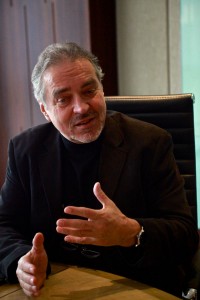
Li Haina: I wonder why you are asking this. Actually, I was born left-handed, but was trained to use my right hand and now I use both almost the same good. When I am painting, it´s an advantage and I can according to a different location, use two hands, for example when I have to paint something in the upper left corner of the room, I I change the brush from the right to the left hand.
Visual China: As one of the earliest masters of The DeTao Masters Academy, what do you think are the advantages of the DeTao education?
Li Haina: I was actually the first DeTao master, and now they have around 130 masters and over 120 staff. I think the design in China is very promising. Chinese people may know Picasso, but no one in the West knows about the Chinese art design. The West may feel that China’s design is only plagiarism or just copied work, but that´s not true. Of course, it has to be developed which is the reason we came to China. But nevertheless, I am sure that China has a great future in art and design. The reason DeTao attracted me was because it was unlike any other educational system. In fact, many university professors do not understand and therefore not teach their students the skills to survive. Some people think that an artist should live in heaven and considered as a genius. In my opinion, artists are nothing else than a shoemaker, a carpenter or other professionals. They just have to develop their own art and skills.
Artists don´t like to talk about money, but if they do not make much money, they fail, and the failure is the responsibility of the teacher. The reality is that every student should be allowed to acquire a skill not only in his field of art but also to survive in the real world. In doing freelance art for several decades, I know how to market and sell my works. All DeTao professors not only teach knowledge, but also the ability how to apply the learned skills. It´s more a Master-Apprentice rather than a Professor-Student education form.
Visual China: In art education, what is the difference of domestic and foreign education?
Li Haina: Before I heard of “Shanghai’s most outstanding students,” in a review of the international rating of knowledge and school training. I think, such a title is absurd, because I consider grades are not everything, not representative creativity and talent to survive in the reality. In China, parents only can have one or two children. For this, they want their children to fulfill their own dreams, so give them a lot of pressure to achieve high goals. But living for other person´s goals is actually a loss. Shanghai´s level in regards to academic performance is very high, but behind this phenomenon is that students are encouraged with enthusiasm and portray a rebellious mood. In the long run, there will be those successful who are passionate, loyal to their classmates and help them catch up. I can only say what I feel, that if you do not like what you’re doing now, then find those things that you like and are good at.
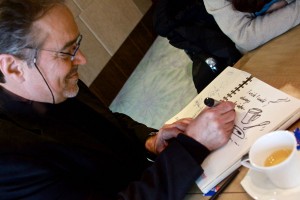 Visual China: For arts students, who, survival may be a very real problem, how do they solve the contradiction between art and life, to apply their knowledge to achieve the purpose?
Visual China: For arts students, who, survival may be a very real problem, how do they solve the contradiction between art and life, to apply their knowledge to achieve the purpose?
Li Haina: My parents were art teachers and at home we had a total of nine children, I was fourth. We all have inherited out parents’ artistic talent and painting for us was as naturally as speaking. Although we had a very poor home growing up; we had been surrounded by a vibrant artistic atmosphere which you cannot by for money. I have several brothers and sisters that later in life made their living with art-related work, but not everybody succeeded. For me it was clear, to make my money through art. As a child my father often painted for the church asking for nothing in exchange and my mother said, “How can you do it for free, we have no food to eat.” My father said, “God will reward us in heaven!” And my mother replied, “watch out if we don’t’ have to prove it soon because we all are going to die for hunger when you don´t get money for your work”. I thought, I would instead always ask for a good pay and would live in the castle, to have a luxury car, instead of our old dangled car we children had to squeeze in and also a housekeeper, who would have to pay the food deliverer. My siblings always laughed about my ideas, but not later when they saw that it became true.
Later, I went to Italy, because anyway, if I am poor the poor, it´s better to be hungry in a sunny place than in the 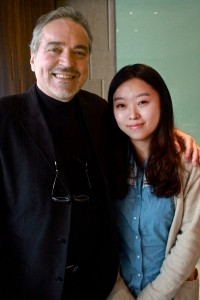 German rainy. Italy is a very interesting place, full of art, paintings and beautiful architecture and even without a professor, you can learn only by watching and copying the art work of the Renaissance masters. There I became addicted to mural painting. Later I returned back to Germany, where the gallery owner throw me out by I was 200 years too late with my kind of art and now came back which was even 400 years too late. But I didn´t get discouraged, I offered to paint murals and some friends began to be interested in it, giving food or to provide room and board in exchange. Later, I painted a restaurant against a half year free food which then happened to be featured on the cover of a very popular magazine. I began to receive a lot of solicitation calls. I also began to ask for real money for my work and suddenly felt the skies open up as life began to develop into my career.
German rainy. Italy is a very interesting place, full of art, paintings and beautiful architecture and even without a professor, you can learn only by watching and copying the art work of the Renaissance masters. There I became addicted to mural painting. Later I returned back to Germany, where the gallery owner throw me out by I was 200 years too late with my kind of art and now came back which was even 400 years too late. But I didn´t get discouraged, I offered to paint murals and some friends began to be interested in it, giving food or to provide room and board in exchange. Later, I painted a restaurant against a half year free food which then happened to be featured on the cover of a very popular magazine. I began to receive a lot of solicitation calls. I also began to ask for real money for my work and suddenly felt the skies open up as life began to develop into my career.
I always did what I wanted to do. So my life experience tells you that what you want to do must be done, but you must be well prepared before you can make a living and a good teacher can help you find a way to let you do what you want and also to survive with it.
Visual China: Thank you for the interview, Professor Latzke
About Li Haina: Li Haina (Rainer Maria Latzke, formerly known as: Lai Cike) is one of the greatest contemporary mural artists. He led the contemporary interior mural renaissance, was titled by numerous media as “a contemporary Michelangelo.” “Forbes” magazine described him as the most significant painter of the 90th decade. French “Mason and Jardin” magazine praised him as “the genius of trompe l´oeil”. Russian artist trade union ranked him in the list of the world best artists of the last four centuries. His mural work can be seen throughout the world, including United Arab Emirates royal palaces, rock stars and large enterprises like Mercedes-Benz. He is a professor at the University of Utah, inventor of the revolutionary Frescography replication technology and founder of the US based Institute of Frescography (IOF).












